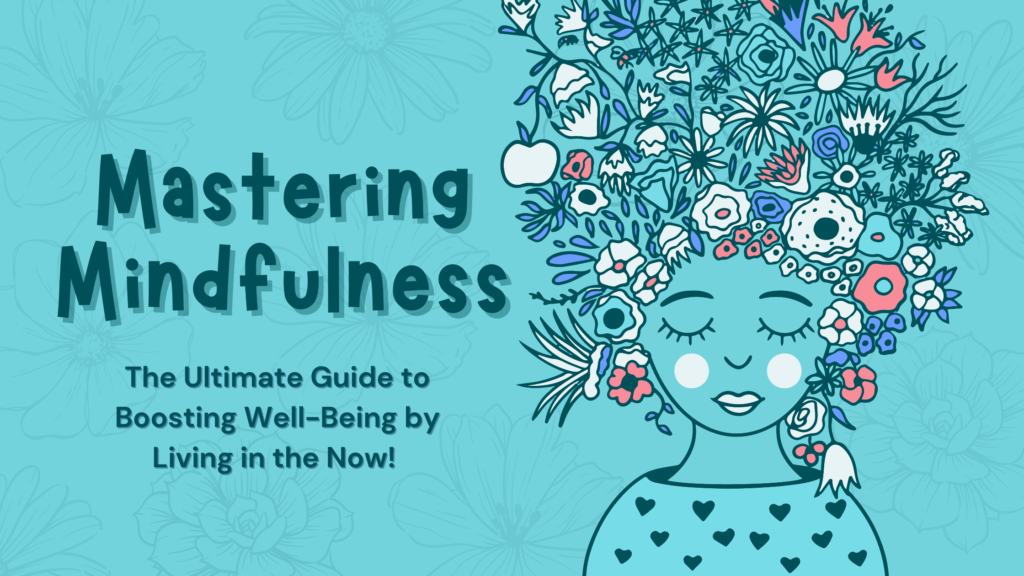Longing for a wellness transformation that can anchor you firmly in the fleeting present? Welcome aboard, as mindfulness might be your secret sauce! Mindfulness is an art, a practice of immersing yourself fully in the ‘now’, observing your thoughts, emotions, and sensations without an iota of judgment. Touted for its truckloads of mental and physical health perks, this article will take you on an adventurous quest exploring mindfulness, its ties to well-being, and your actionable guide to mastering it.
Grasp Mindfulness: The Prologue to Mastering It
To embark on this journey, it’s crucial to familiarize yourself with what mindfulness entails. Imagine yourself as an actor in the grand play of life, entirely engrossed in the current act. This is mindfulness. It’s about acknowledging your thoughts, emotions, and sensations without prejudice. Engaging in mindfulness regularly is akin to mental conditioning, enhancing your awareness and helping you manage them effectively. The cherry on the cake? You sign up for a life with less stress, an uplifted mood, and a profound sense of well-being.
Key Revelations
- Mindfulness: Your superpower to stay fully engaged in the present, taking note of your thoughts, feelings, and sensations without criticism.
- Regular mindfulness practice: A magic elixir busting stress, lifting mood, and enhancing well-being.
- Aspiring to master mindfulness? Understanding its essence, the role it plays in boosting well-being, and practical steps to integrate it into your lifestyle is the key.
Demystifying Mindfulness
Mindfulness Unveiled: Its Roots and Principle
Mindfulness isn’t a millennial invention but a time-honored practice embedded in Buddhist meditation. It nudges you to be an alert observer of your thoughts, emotions, and surroundings, minus any judgment or attachment, fostering a deeper self-understanding and broadened worldview.
The foundational principle of mindfulness is embracing the ‘now’, rather than ruminating over past or speculating about the future. The result? A life with less stress, more focus, and amplified well-being.
The Impact of Mindfulness on Our Brain and Body
Scientific research upholds the multifaceted benefits of mindfulness. Studies indicate that mindfulness practice can rewire the brain, bolstering areas associated with attention, emotional regulation, and empathy.
And that’s not all! Mindfulness doesn’t just boost mental health but brings physical advantages. Think reduced inflammation, better immune function, and improved sleep quality.

The Magic of ‘Living in the Now’
Dwelling in the present moment isn’t just a component of mindfulness, it’s the heart and soul of it. Concentrating on the ‘now’ liberates us from the shackles of past regret and future worries, nurturing a sense of peace and contentment.
Practicing mindfulness contributes to developing self-awareness and emotional intelligence. With an enhanced awareness of our thoughts and feelings, we can manage them better, leading to increased happiness and fulfillment.
To sum up, mindfulness is an empowering practice that enables us to revel in the present moment, combat stress and anxiety, and boost overall well-being. By unraveling the origin, principles, and scientific support of mindfulness, we can start to weave this practice into our daily tapestry and harvest its plentiful benefits.
The Mindfulness-Wellness Matrix: Unearthing the Bond between Mindfulness and Well-being
Seeking a life abundant in fulfillment? The road may be paved with the stepping stones of mindfulness. Not just an instrument to anchor in the present and maintain focus, mindfulness also acts as a catalyst for overall well-being. Let’s venture into the intricate intertwining of mindfulness and well-being.
Mindfulness: A Beacon for Mental Health
The powers of mindfulness ripple into our mental health sphere, leaving profound effects. Practicing mindfulness offers you a unique lens to view your thoughts and emotions without judgment, serving as an antidote to stress, anxiety, and depression. It’s like a makeover for your life’s outlook and an instant mood enhancer!
Research proves that mindfulness-based interventions work wonders in treating mental health disorders like depression and anxiety. Such interventions typically include mindfulness meditation, aiding us to fine-tune our focus and fostering self-awareness.
Mindfulness: The Health Companion You Never Knew You Needed
Intriguingly, the boons of mindfulness extend beyond the mind and seep into physical health. When you immerse in mindfulness, you become the mindful architect of healthier life choices and proactive wellness activities. You might just start hitting the gym, nibbling on nutritious food, or prioritizing your sleep.
Studies lend credence to the fact that mindfulness ameliorates chronic pain symptoms and bolsters immune function. It even acts as a guard against heart diseases by keeping blood pressure levels in check!
Anecdotes and Studies that Echo the Mindfulness-Wellness Connection
Several real-life stories and studies unfurl the deep-rooted connection between mindfulness and well-being. For instance, a study published in the Journal of Psychosomatic Research points to mindfulness meditation as a reliever of irritable bowel syndrome (IBS) symptoms. Another research piece in the Journal of Alternative and Complementary Medicine depicts how mindfulness meditation can lessen post-traumatic stress disorder (PTSD) symptoms.
Real-life stories also illustrate mindfulness’ potency. Many have shared how mindfulness has been their secret weapon to vanquish addiction, manage chronic pain, and uplift their life quality.
Actionable Steps to Wield the Magic Wand of Mindfulness
Mastering mindfulness calls for regular practice. Here’s your golden guide to simple mindfulness exercises accessible anytime, anywhere:
Bite-sized Mindfulness Exercises:
- Breathing Exercises: Concentrate on your breath, noticing its rhythmic dance in and out. A count or a mantra can be your anchor to a wandering mind.
- Body Scan: Start a journey from your toes, slowly moving upwards, attentively sensing each part.
- Mindful Eating: Turn eating into a sensory exploration. Relish the flavor, texture, and aroma of every bite.
- Mindful Walking: Pay attention to your foot touching the ground, the rhythmic leg movement, and the surrounding environment.
The Role of Meditation in Spreading the Mindfulness Magic:
Meditation is a mindfulness-booster. Here are some starters to help you dip your toes in the meditation pool:
- Find a Quiet Place: Seek a serene spot free of disturbances.
- Get Comfortable: Sit comfortably, back upright and feet grounded.
- Focus on Your Breath: Observe the life-giving breath flowing in and out.
- Start Small: Begin with a few minutes and progressively extend your meditation duration.
Everyday Mindfulness Integration Tips:
- Be Present: Concentrate on the task at hand, saying no to multitasking.
- Take Mindful Breaks: Check in with yourself during the day and engage in mindfulness.
- Cultivate Gratitude: Reserve some time each day for a gratitude check.
- Mind Your Thoughts: Attentively observe your thoughts and emotions without judgment.
By adopting these exercises and weaving mindfulness into our daily grind, we can become mindfulness maestros and savor its multi-dimensional benefits.
Overcoming Obstacles on the Mindfulness Path and Embracing Mindful Living
While setting out on the mindfulness journey, it’s normal to stumble upon misconceptions and obstacles. Here, we’ll identify these common stumbling blocks and discover the strategies to clear the mindfulness path.
Demystifying Misconceptions and Obstacles
Mindfulness, although simple in concept, brings its share of misunderstandings and challenges. Here are some common ones:
- The ‘Easy’ Misconception: Contrary to common belief, mindfulness necessitates dedicated effort and practice. It can be challenging initially to focus on the present and shrug off distractions.
- The ‘Quick Fix’ Misconception: Mindfulness is not a magic wand for instant stress relief or anxiety cure. It’s a long-term practice demanding consistency and patience.
- The ‘Stop Thoughts’ Misconception: Mindfulness is not about pressing the pause button on thoughts, but about acknowledging and accepting them without judgment.
Strategies to Pave the Way for Mindfulness
Conquering mindfulness challenges becomes easier with these strategies:
- Start Small: Embark with a few minutes of daily mindfulness practice, gradually expanding the duration as comfort grows.
- Be Consistent: Make mindfulness practice a daily ritual. Dedicate a specific time each day to practice mindfulness.
- Be Patient: Instant results are not the goal. Mindfulness demands patience and persistence.
- Practice Self-Compassion: Extend kindness to yourself. Judging yourself for distractions or struggles during mindfulness practice is counterproductive. Remember, mindfulness is a journey, not a destination.
Ensuring Consistency in Practice
To weave consistency into your mindfulness practice:
- Create a Routine: Establish a mindfulness practice routine with a specific time and place daily.
- Use Reminders: Leverage phone or computer reminders to prompt mindfulness practice.
- Find an Accountability Partner: Share your mindfulness journey with someone interested in the practice and commit to practicing together.
Embracing Mindful Choices in Lifestyle
Mindful living is an art of making conscious choices that enhance well-being. Incorporating mindfulness into our daily lives begins with being aware and present in our choices. Let’s explore how to breathe mindfulness into our lifestyle choices.
Importance of Mindful Eating, Exercising, and Other Lifestyle Habits
Mindful Eating: Mindful eating is an immersive sensory experience, paying attention to the food, relishing each bite, and being aware of hunger and satiety signals. It paves the way for healthier choices and enhanced enjoyment of food.
Mindful Exercising: Mindful exercise is about being present during physical activity. Focusing on breath, sensations, and movements can enrich the workout experience and prevent injuries.
Other Lifestyle Habits: Mindfulness can seep into other lifestyle aspects such as sleep, work, and socializing. Being aware of our needs and limitations enables us to make well-being-focused choices and steer clear of burnout.
Tips for Making Mindful Choices
Cultivating mindful choices involves awareness, intention, and practice. Here are some tips:
- Pause and Breathe: Before decision-making, take a moment to pause and breathe.
- Tune In: Listen to your body and emotions. Let them guide your choices.
- Long-term Perspective: Reflect on the long-term impact of choices on your well-being.
- Question Habits: Notice automatic patterns and evaluate their usefulness.
- Embrace Self-compassion: When mistakes occur, respond with self-compassion and forgiveness.
Cultivating a Mindful Environment
Our environment can foster mindfulness and well-being. Here’s how to create a mindful environment:
- Minimize Distractions: Reducing distractions and clutter promotes focus and tranquility.
- Surround with Positivity: Choose to be around supportive and positive people.
- Infuse Nature, Art, Music: Incorporate elements of nature, art, or music into your surroundings.
- Group Mindfulness: Practice mindfulness with others in group meditation or yoga sessions.
Embracing mindfulness in our lifestyle choices and environment boosts our well-being and anchors us more securely in the present moment.
A Real-Life Story of Transformation through Mindfulness
Understanding the transformative power of mindfulness can be best grasped through real-life experiences. Let’s dive into the story of John, a marketing executive, who managed to quell his anxiety and stress through mindfulness.
John’s Journey from Chaos to Calm
John, a 35-year-old marketing professional, found himself ensnared in the tight grip of anxiety and stress. Despite his various attempts at different therapies and medications, the escape route seemed elusive. His edginess was perpetual, his thoughts, incessant.
An online stumble upon a mindfulness meditation video led John to a path he hadn’t ventured before. His initial skepticism morphed into curiosity and hope as he began noticing positive changes after a few sessions. A sense of relaxation seeped in, his focus improved, and his anxiety gradually began to ebb.
The Ups and Downs of the Mindfulness Path
John’s journey wasn’t a cakewalk. His first few attempts at sitting still and quieting his mind were a struggle. His inconsistent practice often had him missing out on days or even weeks of mindfulness exercises.
Yet, determination steered him ahead. He began his daily mindfulness ritual with bite-sized sessions, gradually increasing the duration as he grew comfortable. Over time, John started reaping significant benefits. He found his stress and anxiety levels more manageable, his engagement in daily life heightened, and his work and interpersonal relationships improved.
The Profound Impact of Mindfulness on Life
Mindfulness left an indelible impact on John’s life. He discovered a sense of grounding and centredness he hadn’t experienced before. Equipped with better coping mechanisms for life’s challenges, John became more self-aware, gaining a deeper understanding of his thoughts and emotions.
As an ardent advocate for mindfulness today, John encourages others to embark on this journey, firmly believing in mindfulness’s transformative potential and its ability to anchor individuals in the present.
Expert Views and Research on Mindfulness and Well-being
Drawing insights from expert opinions and scientific research can further emphasize the benefits of mindfulness.
Expert Opinions: Insightful Nuggets from Jon Kabat-Zinn and Dr. Dan Siegel
Jon Kabat-Zinn, a key figure in the mindfulness field, developed the Mindfulness-Based Stress Reduction (MBSR) program. According to him, mindfulness means “paying attention in a particular way: on purpose, in the present moment, and non-judgmentally”. Kabat-Zinn champions mindfulness as a tool to reduce stress, improve mental and physical health, and enhance overall well-being.
Another expert voice in the field, Dr. Dan Siegel, a Clinical Professor of Psychiatry at the UCLA School of Medicine, sees mindfulness as a catalyst for developing “mindsight,” or the ability to recognize and understand one’s thoughts and emotions. He also emphasizes how mindfulness fosters empathy and compassion, leading to healthier relationships and improved well-being.
The Power of Mindfulness: Evidenced by Latest Research Findings
Scientific research backs the benefits of mindfulness, affirming its positive impact on mental and physical health. A study in the Journal of the American Medical Association found that mindfulness-based stress reduction effectively treats chronic pain. Another study in the Journal of Consulting and Clinical Psychology demonstrated that mindfulness-based cognitive therapy effectively combats depression.
Furthermore, research underscores mindfulness’s role in stress reduction and overall well-being improvement. A study in the journal Health Psychology found mindfulness as a viable strategy to cope with stress and boost immune system function. Additionally, the Journal of Happiness Studies illustrated how mindfulness contributes to greater subjective well-being and life satisfaction.
Mastering Mindfulness: Professional Tips and Techniques
Interested in cultivating mindfulness? Various techniques and practices, shared by professionals, can be your guiding light.
Mindful Techniques: Body Scan and Mindful Breathing
One of the popular techniques is the ‘Body Scan.’ It is a mindfulness exercise that requires you to focus attention on different body parts and observe any sensations. You might notice the subtlety of your breath against your nostrils or the pressure of your feet against the floor— every sensation matters.
Another powerful technique is ‘Mindful Breathing.’ The essence of this practice lies in focusing your attention on the ebb and flow of your breath. Recognize the thoughts and distractions that emerge, gently acknowledging them without resistance.
The Key: Regular Practice and Non-Judgmental Attitude
Mindfulness is like a muscle— the more you flex it, the stronger it becomes. Regular practice, even a few minutes daily, can help weave mindfulness into your routine fabric. Also, approaching mindfulness with a non-judgmental lens is essential. Accept thoughts and emotions as they come, without a desire to alter them.
With patience, persistence, and practice, mindfulness transforms into a formidable ally for your well-being and a medium to truly live in the present.
Wrapping Up: The Power of Mindfulness
In our exploration of mindfulness, we’ve discovered its potential as a potent tool for enhancing physical and mental well-being. It is a gentle guide helping us to anchor in the present, curtail stress, and boost our happiness quotient.
The myriad benefits of mindfulness have unfolded before us—its ability to alleviate anxiety, depression, and chronic pain, enhance cognitive function, focus, and attention, and uplift our relationships.
By interweaving mindfulness into our daily existence, we can bask in a greater sense of calm, clarity, and inner peace. No matter where we stand on our mindfulness journey—novices or seasoned practitioners—there is always an opportunity to delve deeper and continue harvesting its benefits.
Continue your exploration of mindfulness, find ways to embed it into your daily routine—be it through meditation, mindful breathing, or simply by seizing a few moments to engage with the present. Mindfulness can be the guiding light to happier, healthier, and more fulfilling lives.
Frequently Asked Questions: Unveiling the Basics of Mindfulness!
What are some simple mindfulness exercises?
Numerous simple mindfulness exercises can anchor you in the present moment. ‘Deep Breathing’ is a classic one— take deep breaths and focus on the sensation of air coursing in and out of your body. ‘Body Scanning,’ starting from your toes and gradually moving up to your head, is another powerful mindfulness exercise.
How can mindfulness improve my mental health?
Mindfulness can significantly benefit mental health— alleviate anxiety and depression symptoms, elevate mood, and foster overall well-being. By embracing mindfulness, you cultivate awareness of your thoughts and emotions and learn to exercise control over them.
What are the benefits of living in the present moment?
Living in the present moment ushers a plethora of benefits for your mental health and overall well-being. It can trim down stress and anxiety, enhance mood, and amplify feelings of happiness and contentment. When you focus on the ‘now,’ you learn to appreciate life’s minutiae and cultivate a deep-seated sense of gratitude.
How can mindfulness help with stress and anxiety?
Mindfulness is a potent antidote to stress and anxiety. Mindful practices help you observe and understand your thoughts and emotions better, giving you a greater sense of control. This understanding and control can significantly diminish stress and anxiety, fostering overall well-being.
What are some tips for incorporating mindfulness into daily life?
Mindfulness can be incorporated into daily life in myriad ways. Setting aside a few minutes each day to practice mindfulness exercises like deep breathing or body scanning is a good start. Strive to be mindful during mundane activities like eating, walking, or conversing with others. When your attention is rooted in the present moment, you learn to appreciate life’s little joys and cultivate gratitude.
Can mindfulness improve relationships with others?
Absolutely! Mindfulness can significantly improve your interactions and relationships with others. It helps you be present and attentive in your dealings, fostering empathy and compassion. This not only enhances communication but also minimizes conflict and strengthens relationships.
The End…Or Is It?
Congratulations! You’ve journeyed to the end of this post. In reward, we present you with an imaginary medal of mindfulness! 🏅 (Sorry, our budget didn’t cover real ones). But seriously, we’re thrilled to have you here.
Now that you’ve made it this far, why not take another leap and share your mindfulness experiences? Drop us a comment, join a forum discussion, or, if you’re feeling extra brave, spread the mindfulness love by sharing this post on social media.
Don’t forget our posts are like boomerangs, they always come back with something new. So bookmark us, pin us, add us to your favorites, and make sure to check back regularly for updates. And remember, there’s always room for one more at our mindfulness party. So, come on in, the door’s always open!



